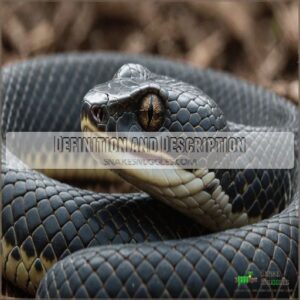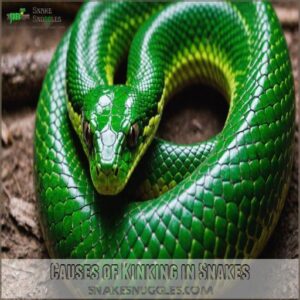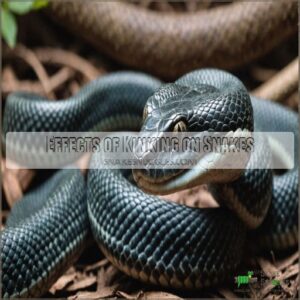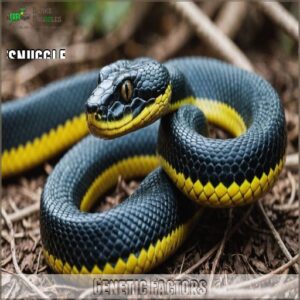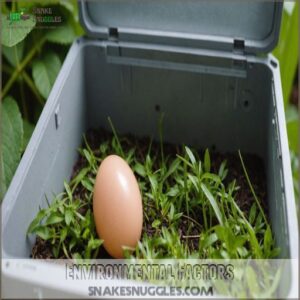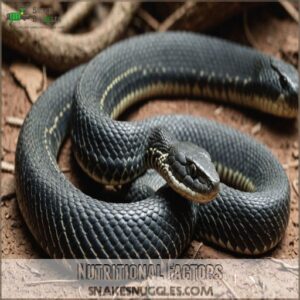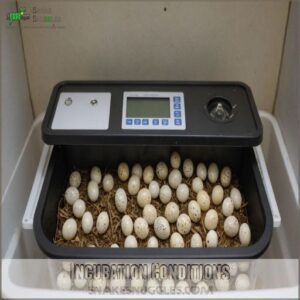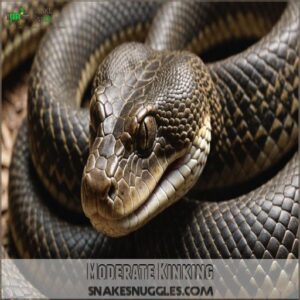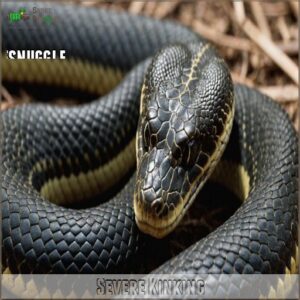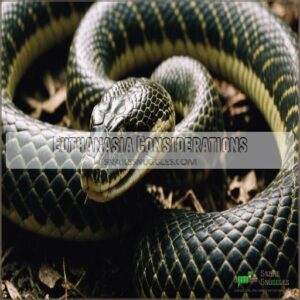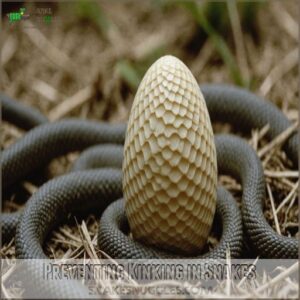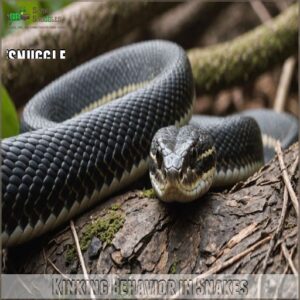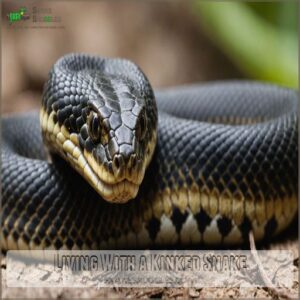This site is supported by our readers. We may earn a commission, at no cost to you, if you purchase through links.
 Kinking in snakes is when a snake’s spine develops unnatural bends or twists, making it look like the snake took a wrong turn at Albuquerque!
Kinking in snakes is when a snake’s spine develops unnatural bends or twists, making it look like the snake took a wrong turn at Albuquerque!
These kinks can be minor or severe, affecting anything from their slithering style to their digestion.
Kinking often hails from genetic factors, incubation missteps, or poor nutrition.
Imagine trying to digest dinner with a knot in your intestine—not fun, right?
Although it sounds tricky, understanding the causes helps you manage or even prevent it.
Curious to know how to keep your scaly friend smooth and straight?
Keep reading for some fascinating insights and helpful tips.
Table Of Contents
- Key Takeaways
- What is Snake Kinking
- Managing a Kinked Snake
- Preventing Kinking in Snakes
- Kinking Behavior in Snakes
- Living With a Kinked Snake
- Frequently Asked Questions (FAQs)
- What is kinking in a snake?
- Why do snakes kink?
- What is a kinked drain snake?
- What does it mean if a snake has a kinked spine?
- Why would a snake look kinked?
- What does kinking mean in snakes?
- Can a snake live with a kink?
- What are tail kinks in snakes?
- Can kinking be detected in snake eggs?
- What snake species never exhibit kinking?
- Is kinking painful for snakes?
- How do kinks affect a snakes lifespan?
- Can kinking be reversed in snakes?
- Conclusion
Key Takeaways
- You’ll learn that snake kinking is a condition similar to scoliosis in humans, where a snake’s spine bends at odd angles, affecting its mobility and digestion.
- Understand that genetics, incubation conditions, and nutrition play significant roles in causing kinks, making careful breeding and environmental management crucial.
- It’s vital to recognize how kinks can impact a snake’s health and lifespan, with severe cases potentially leading to significant health challenges.
- Prevention and management are key, focusing on proper breeding practices, maintaining optimal temperature and humidity during incubation, and ensuring a balanced diet for your snake.
What is Snake Kinking
If you’ve ever noticed a snake with its spine bending at odd angles, you’re looking at a condition known as kinking.
Think of it like scoliosis in humans, where the spine doesn’t quite get the memo to stay straight, often leaving the snake with surprising zig-zag patterns.
Definition and Description
Snake kinking is like discovering unexpected zig-zags on a highway—it’s when a snake’s spine bends at odd angles.
Imagine scoliosis but for reptiles.
As snakes also use body language to communicate, such as defensive posturing signs, it’s important to understand these physical changes.
This condition varies in severity, with slight bends being minor speed bumps and severe twists derailing the snake’s daily life.
Identifying kinks helps understand their impact on a snake’s anatomy and overall well-being.
Causes of Kinking in Snakes
Understanding why snakes kink is like piecing together a puzzle. It’s often a mix of factors: Research on snake kinking genetics is available through online resources such as products for snake kinking genetics.
- Genetics: Some snake morphs are more prone to kinking due to inherited traits.
- Incubation: Temperature changes during incubation can trigger kinking.
- Nutrition: While unproven, poor nutrition might play a role.
- Husbandry: Incorrect breeding practices increase the risk.
Effects of Kinking on Snakes
Seeing your snake struggle due to kinking can be heart-wrenching.
This condition throws a wrench in digestion, movement, and growth.
Imagine trying to dance with your shoelaces tied together—that’s mobility with severe kinking.
The stress this causes could lead to bigger issues and even mortality.
While mild kinking might slide by unnoticed, more severe cases can pose serious challenges.
Genetic Factors
You’ve looked at how kinking impacts snakes, so let’s chat about genetics.
Morph prevalence, often seen in some snake breeds, hints at kinking inheritance.
Imagine trying your luck at a game where the odds aren’t in your favor—genetic mutations can sneak up like that.
Breeding selection matters here, avoiding passing kinking tendencies to future generations.
Environmental Factors
Besides genetics, a snake’s environment plays a big role in kinking.
Incubation temperatures and humidity are especially important.
Think of it like baking a cake – the oven needs to be just right!
Too much heat or humidity during incubation can increase the chances of kinking.
Conversely, consistent, proper incubation temperatures and humidity control can help prevent it.
Even the substrate (the bedding material in the incubator) can impact development.
Stress on the mother snake can also influence the offspring.
Nutritional Factors
Keeping an eye on their dietary impact is important when it comes to kinking in snakes.
While mineral needs and potential vitamin deficiencies haven’t been nailed down as direct causes, ensuring a balanced diet can’t hurt.
Think of it as nutritional management—choosing the right foods to keep your snake’s body in tip-top shape.
It’s the little choices that make a difference!
Incubation Conditions
Imagine trying to bake a perfect cake; egg incubation is just as precise.
1. Keep humidity levels steady—too dry, and it’s like overcooking your masterpiece.
2. Temperature control is essential; think of it as setting the oven right.
3. Substrate selection is the unsung hero, ensuring breathability.
4. Ventilation systems help whisk away excess heat, keeping everything balanced.
Managing a Kinked Snake
When managing a kinked snake, you need to assess the severity of the condition, as mild bends might just add a little character, while severe kinks could impact their health.
You’ll need to make informed decisions, from deciding whether extra care or even euthanasia is the most humane choice for your scaly friend.
Mild Kinking
Mild kinking in snakes often occurs at the tail and generally poses little impact on their behavior or health.
Picture a slight bend that barely disrupts daily life.
These mild kinks don’t require special treatment, but always monitor your snake for changes.
They can still slither gracefully, showcasing their unique charm without missing a beat in the reptilian orchestra.
Moderate Kinking
While gastrointestinal issues in snakes, including those caused by Cryptosporidiosis infections, can be severe and require prompt veterinary care, mild kinks mightn’t disrupt much, moderate kinking in snakes can pose digestion issues.
You’ll notice awkward bends in young snakes, potentially leading to long-term effects on their quality of life.
Check out these specialized products for kinked snake care to find helpful tools and resources.
Keeping an eye on treatment options can help, but it might mean careful monitoring and adjustments to their care routine—think of it like a special diet for picky eaters!
Severe Kinking
In severe cases, kinking can twist a snake’s spine into a zig-zag, seriously impacting digestion and quality of life.
Imagine this kink as a stubborn garden hose—nothing flows smoothly.
With the potential for breeding complications, decisions about care can be tough.
Your snake might look like a delicate origami, but without careful management, suffering could make you reconsider its comfort options.
Euthanasia Considerations
Facing a severely kinked snake presents ethical dilemmas.
Three factors guide your decision: 1. The snake’s suffering; 2. Its quality of life; 3. Available humane methods.
Seeking guidance from a reptile-savvy vet, who understands the unique anatomy of snakes, such as their three-chambered heart and specialized care needs Understanding reptile vet, is essential in making the most ethical choice.
Owner responsibility includes making the most ethical choice. Remember, you’re prioritizing your snake’s well-being.
Consult a vet for guidance; legal implications vary by location.
Preventing Kinking in Snakes
Preventing kinking in snakes is all about maintaining the right environment and making smart breeding choices.
You’ll need to keep a close eye on temperature and humidity during incubation, ensuring that your snake eggs are comfortable and happy—after all, nobody wants a "kink" in the plan!
Selective Breeding
Breeding snakes with a thorough understanding of snake breeding genetics and inheritance helps prevent inbreeding and maintain a diverse gene pool. Breeding snakes without kinking can enhance genetic diversity while balancing ethical implications.
Focus on choosing healthy snakes, avoiding morphological changes and supporting conservation concerns.
| Aspect | Importance | Action |
|---|---|---|
| Genetic diversity | Preserves robust gene pool | Choose diverse mates |
| Breed standards | Maintains species quality | Follow guidelines |
| Ethical implication | Ensures humane breeding | Avoid kinked parents |
Selecting wisely helps guarantee the best for your slithery friends!
Proper Incubation Techniques
When you’re tackling snake breeding, proper incubation techniques are key.
Think of egg care as a spa treatment—humidity levels and incubation materials work together to create comfort.
Choose the right materials, like vermiculite, to cradle those precious eggs.
Monitor humidity closely, ensuring it’s just right for the specific species, and voilà, you’re nurturing future healthy snakes.
Maintaining Optimal Temperature
Keeping your eggs at the right temperature is key to avoid kinking in snakes.
Too much fluctuation, and you’re playing a risky game of snake Jenga!
You can find a variety of heat mats for snakes online to help maintain a stable temperature.
Use reliable heat mats and make sure your incubator setup is spot-on.
Always double-check with an accurate thermometer because precision is your best friend here.
- Monitor regularly for stability
- Invest in quality gear like heat mats
- Calibrate thermometers regularly
Providing Humidity Control
Humidity levels play a key role in preventing snake kinking.
Choose the right incubator type for consistent moisture, or consider misting systems to maintain the best conditions.
The substrate choice impacts moisture retention—opt for one that balances air circulation to avoid stagnant conditions.
Remember, keeping your snake happy and healthy requires the right blend of tech and nature’s touch.
Kinking Behavior in Snakes
You might be surprised to learn that kinking in snakes isn’t just about quirky spine bends—it’s a behavior that actually helps some snakes move through their environment and avoid predators.
Although it sounds like a serious yoga class, this adaptive trait has practical uses for various snake species, including helping them stealthily navigate tight spaces.
Why Do Snakes Kink
Picture a snake gracefully moving through its world, body language as expressive as a dance.
Kinking in snakes might look like a zig-zag puzzle, but it serves a purpose. It’s often an evolutionary advantage.
Some suggest it aids in hunting techniques, or perhaps it’s a quirky defense mechanism. Others think it’s part of their mating ritual.
It’s all about survival.
Benefits of Kinking Behavior
Kinking behavior in snakes isn’t just for show—it’s packed with benefits.
Imagine a flexible roadmap for escape and hunting!
Kinking boosts your snake’s maneuverability through tight spots or unpredictable terrains.
It also acts as a defensive shield, confusing predators with its zig-zag dance, while adding a touch of stability as your snake winds through its natural playground.
Kinking in Different Species
Exploring kinking in different species reveals intriguing patterns.
In the wild, some snakes utilize kinking for survival tricks, while others show this trait primarily in captivity.
It’s a bit like a snake’s secret weapon: part genetic shuffle, part environmental cue.
Understanding geographic distribution helps us see where kinking pops up naturally, hinting at its evolutionary significance in wild populations.
Common Kinking Snake Breeds
When choosing a snake breed, it’s essential to consider the importance of supporting ethical ball python breeders. Some snake breeds, like Caramel ball pythons and Corn snakes, show higher kinking prevalence.
These species often deal with kinking severity due to genetic factors.
Kinking genetics plays a big role, so breeding considerations are very important.
Though there’s no kinking treatment, other snakes exhibit this trait too.
Understanding these breeds helps manage the condition and improves snake welfare.
Living With a Kinked Snake
Living with a kinked snake requires understanding their unique needs while ensuring they lead a comfortable life.
You’ll need to manage their health, provide a suitable environment, and handle them with care—just remember, even snakes appreciate a little pampering!
Managing a Kinked Snake’s Health
Caring for a kinked snake isn’t as challenging as it sounds.
Prioritize hydration and a diet rich in nutrients. Occasionally, supplements might help, but always consult your vet first.
Regular vet visits make sure you’re on track, spotting any health hiccups early.
Exercise by gently encouraging natural movement can aid digestion and comfort. Think of it as giving a scaly friend some much-needed TLC to thrive.
Providing a Suitable Environment
Creating a cozy nook for your kinked snake involves thoughtful choices.
Make sure the enclosure size matches their needs, offering plenty of room but not so vast they feel lost.
Equip the space with a temperature gradient to let them choose their comfiest spot.
Toss in a few hiding spots and a large water bowl for hydration.
Your snake will feel like royalty.
- Comfort matters: Choose the right size.
- Temperature control: Offer gradients.
- Hide and seek: Provide hiding spots.
Handling and Care of Kinked Snakes
Handling a kinked snake calls for understanding and a gentle touch to make sure its well-being.
You’ll want to create a comforting habitat that offers safety and warmth.
Keep an eye on its diet and exercise, important for its health.
Think of your snake’s housing as a cozy sanctuary, like a snug doghouse for a beloved canine.
| Aspect | Tips for Care |
|---|---|
| Diet | Balanced and nutritious |
| Housing | Secure and temperature-controlled |
| Enrichment | Stimulate with safe objects |
| Exercise | Allow room to move |
| Monitoring | Observe for distress |
Frequently Asked Questions (FAQs)
What is kinking in a snake?
Kinking in snakes means unusual bends in their spine, like scoliosis.
It ranges from subtle curves to severe zig-zags, impacting digestion or mobility.
This condition, often genetic, worsens with age, affecting certain snake morphs more severely.
Why do snakes kink?
Snakes kink for various reasons. Sometimes it’s a birth defect, other times it’s a defense mechanism, or even helps them navigate tricky terrain. It’s like their own special superpower!
What is a kinked drain snake?
Picture a tool meant to reach tricky spots clogging pipes; a kink in a drain snake hinders its ease and effectiveness.
This bend can obstruct its maneuverability, making it less effective in clearing blockages.
What does it mean if a snake has a kinked spine?
If your snake has a kinked spine, it might show up as awkward bends or curves.
This could affect its movement or digestion.
While some kinks are mild, others might be severe enough to cause health issues.
Why would a snake look kinked?
Imagine a snake looking like a zig-zag road.
This kinking could result from congenital issues, genetic factors, or environmental stressors like temperature fluctuations.
These factors can influence its spine to bend strangely, impacting its movement and health.
What does kinking mean in snakes?
Kinking in snakes refers to their spine bending at odd angles, similar to scoliosis in humans.
It’s a congenital condition, potentially affecting the snake’s digestion and mobility, often influenced by genetic and environmental factors during development.
Can a snake live with a kink?
A snake with a kink can often live a decent life, especially if the kink is mild.
Severe kinks might cause digestive issues, affecting its well-being.
It’s like having a hindrance in an otherwise winding journey.
What are tail kinks in snakes?
Tail kinks in snakes involve abnormal spine bends at the tail, sometimes causing mobility and digestion issues.
While mild cases often don’t impact health, severe kinks can indicate congenital defects and might require careful management or veterinary advice.
Can kinking be detected in snake eggs?
A picture’s worth a thousand words, but unfortunately, you can’t see kinks in snake eggs. Kinking’s a postnatal problem, showing up after hatching. So, keep an eye on your hatchlings!
What snake species never exhibit kinking?
No snake species absolutely never exhibit kinking.
While some species are more prone to kinking due to genetic factors, occasional instances can occur across various species due to environmental stresses or individual genetic anomalies.
Is kinking painful for snakes?
Imagine you’ve had a crick in your neck.
For snakes, severe kinking can feel similar and potentially painful, especially when it hinders movement or digestion.
Monitoring their overall comfort and health is essential.
How do kinks affect a snakes lifespan?
Kinks in snakes can shorten their lifespan if severe, as they might impede digestion and movement.
Mild kinks often don’t affect longevity, but severe cases may cause significant health issues, potentially necessitating euthanasia to prevent suffering.
Can kinking be reversed in snakes?
Unfortunately, once a snake develops kinking, reversing it isn’t possible.
This congenital condition persists throughout the snake’s life, like a permanent twist in a coiled rope.
Managing the symptoms is the best course of action.
Conclusion
Did you know that nearly 10% of captive bred snakes can experience kinking?
Understanding what kinking in snakes involves is essential for maintaining their health and well-being.
From genetic causes to environmental factors, several elements play a role in this condition.
While living with a kinked snake presents challenges, proper care and preventive measures can greatly improve their quality of life.
Engage actively in their care, and you’ll help your slithering friend stay as smooth as possible.

